#Morosco
Text
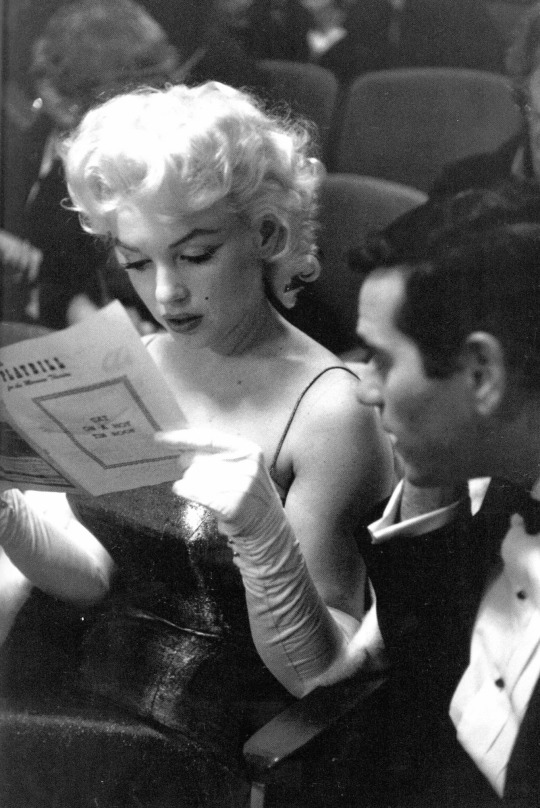
Marilyn Monroe at Morosco Theater to watch "Cat On Hot Tin Roof", March 1955. Photo by Ed Feingersh.
#marilyn monroe#old hollywood#50s#beauty#history#1950s#old hollywood glamour#vintage#photography#retro#ed feingersh#1955#cat on hot tin roof#theater
1K notes
·
View notes
Text
Lit & Found: Excerpt from 'The Secret Of The Morisco'
Lit & Found: Excerpt from ‘The Secret Of The Morisco’
Dar Arab has just published Christiaan James’ crisp translation of Mohammed AlAjmi historical-adventure novel The Secret of the Morisco. An excerpt is now available in the publisher’s website.
The publisher writes:
The Secret of the Morisco is a picaresque tale of Robert, a young Englishman taken captive by the Spanish Armada in the 17th century, as he sails home after procuring an Arabic…
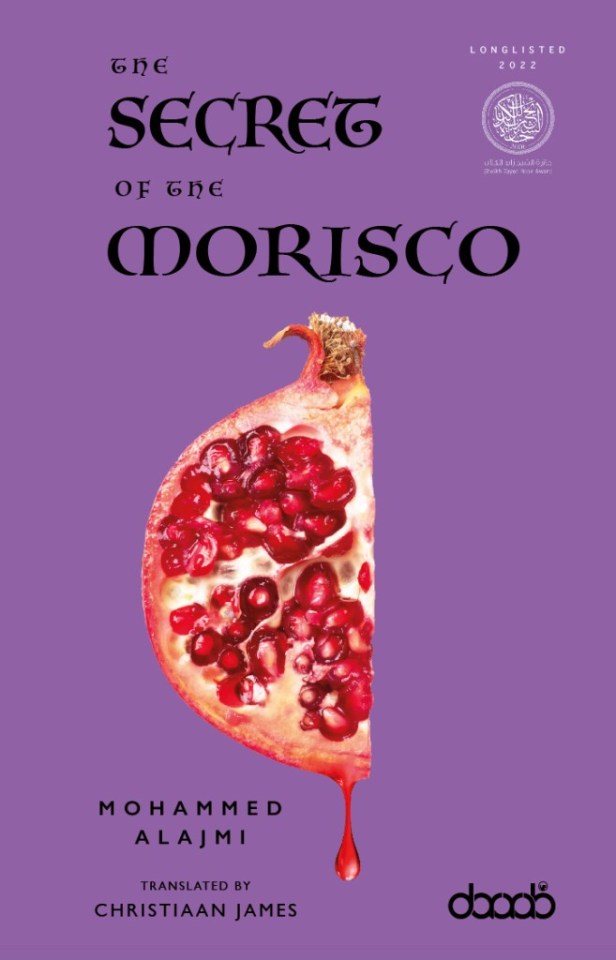
View On WordPress
0 notes
Text
Vanessa Morosco, the new executive director at the American Shakespeare Center in Virginia, is in a similar boat but is facing a new problem. “We still need a certain budget in order to produce enough content because our audience’s expectations haven’t changed, but our donors’ behavior has radically changed,” Morosco said. “During the pandemic, many rose to the occasion to help theatres survive, but as the passion of that moment dies down, we now have donor fatigue.”
19 notes
·
View notes
Photo
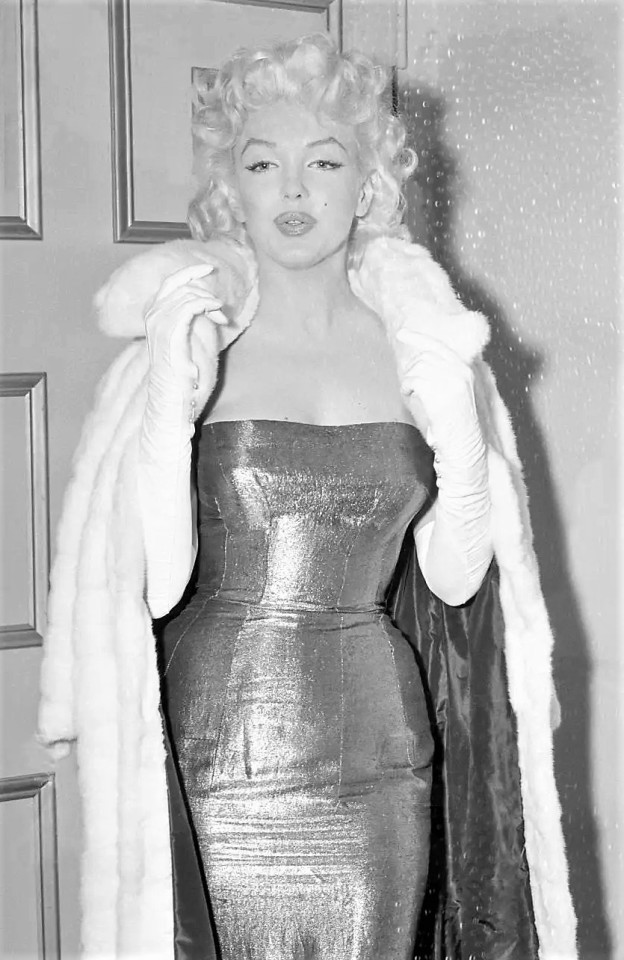
Marilyn Monroe at the opening of Tennessee Williams' play, Cat on a Hot Tin Roof in New York's Morosco Theater, March 1955
616 notes
·
View notes
Text

from Photoplay Magazine, October 1916
Margery Ordway photographed by Dick Stagg
original caption:
THIS IS THE NEW FALL STYLE IN CAMERA "MEN"
Meaning, the style you could fall for. Nor is this a masquerade get-up. Margery Ordway, regular, professional, licensed, union crank-turner at Camp Morosco, has gone into camera work as nonchalantly as other girls take up stenography, nursing, husband-stalking.
#1910s#1916#Margery Ordway#photoplay#fan magazine#classic hollywood#film magazine#my edit#portraits#classic movies#old hollywood#women filmmakers#female filmmakers#silent cinema#silent movie#silent film#silent era#classic cinema#classic film
53 notes
·
View notes
Text
Arthur Miller's "Death of a Salesman", starring Lee J. Cobb, Arthur Kennedy, Mildred Dunnock , Cameron Mitchell, and directed by Elia Kazan, opened at Morosco Theatre in NYC on February 10, 1949.



Arthur Miller's "Death of a Salesman", starring Lee J. Cobb, Arthur Kennedy, Mildred Dunnock , Cameron Mitchell, and directed by Elia Kazan, opened at Morosco Theatre in NYC on February 10, 1949.
35 notes
·
View notes
Text

Max Waldman Colleen Dewhurst as Josie Hogan and Jason Robards as James Tyrone, Jr in Eugene O'Neill's "A Moon for the Misbegotten," The Morosco Theater, 45th St, New York City 1973
Tyrone: We’ve agreed there is only tonight–and it’s to be different from any past night–for both of us.
Josie: (in a forced, kidding tone) I hope it will be. I’ll try to control my envy for your Broadway flames. I suppose it’s because I have a picture of them in my mind as small and dainty and pretty–
Tyrone: They’re just gold-digging tramps.
Josie: (as if he hadn’t spoken) While I’m only a big, rough, ugly cow of a woman.
Tyrone: Shut up! You’re beautiful.
Josie: (jeeringly, but her voice trembles) God pity the blind!
Tyrone: You’re beautiful to me.
Josie: It must be the Bourbon–
Tyrone: You’re real and healthy and clean and fine and warm and strong and kind–
Josie: I have a beautiful soul, you mean?
Tyrone: Well, I don’t know much about ladies’ souls–(He takes her hand.) But I do know you’re beautiful. (He kisses her hand.) And I love you a lot–in my fashion.
--Eugene O'Neill, "A Moon for the Misbegotten" 1947
33 notes
·
View notes
Text
Today you're getting trivia dump on the musical The Drowsy Chaperone because I saw it last night and it's immediately become one of my dream shows (with the dream role of Man in Chair of course- look as a theatre kid who can't sing of course I'm going to latch onto a monologue-heavy character).
Let's begin!
The musical originated as an entertainment piece for the bachelor party of real life couple Bob (Robert) Martin (Canadian writer and actor) and Janet van de Graaf (Canadian improv and television artist). It was performed at the Rivoli Night Club and the admission costs were used to help fund their wedding
The original show did not have the role of the Man in Chair!
Despite having less than stellar reviews (notably being called a "sleeper" and having "forgettable" songs by critic Ben Brantly), TDC recieved thirteen Tony nominations and won five (Book, Original Score, Featured Actress, Scenic Design, and Costume Design)
The first translated version of the show opened in Japan (January 5th, 2009)
In the original Broadway production, during the Man in Chair's "intermission monologue", there's an added line about the Morosco theatre being torn down and a hotel being put in it's place. This line is a reference to the Marquis Theater (where the run took place) being part of the Marriott Marquis complex which was built where the Morosco Theater once stood.
The use of a deus ex machina in the form of Trix's plane at the end of the second act is one of the most literal version of the trope. The history of the term comes from ancient Greek performances, where, in resolution to conflicts, the Greek gods would appear in the show, often being delivered to the stage via a crane. So, the appearance of a character who can resolve the unsettled issue via a device from the sky is a fitting homage to the trope.
The Drowsy Chaperone is qualified as both a parody and a pastiche. If you didn't know what a pastiche means (aka me about five minutes ago), a parody mocks aspects while a pastiche celebrates aspects. Some examples of other pastiches are Rosencrantz and Gildenstern are Dead (for Hamlet) and The Second Mrs Darcy (Pride and Prejudice).
The song Love is Always Lovely in the End replaced a song in the original production titled I Remember Love
In many productions, the animal Robert is compared to in Bride's Lament is changed from a monkey to a bunny to avoid racist undertones.
Aldopho says his name 15 times in the song I am Aldopho (the chaperone says it four times)
Whilst on Broadway, TDC had 32 previews and 674 performances before it closed in 2007.
Robert and George's tap dance before Underling's entrance in Cold Feet is approximately 1 minutes and 32 seconds long.
The longest song on the cast recording is Bride's Lament at 5:13, whilst the shortest (excluding Man in Chair's actor backgrounds) is the Act 1 Finale with 47 seconds.
#the drowsy chaperone#musical theatre#trivia#sutton foster#broadway#theatre#theater#theatre kid#tdc#robert martin#janet van de graaff
13 notes
·
View notes
Text
'My Dear, Put Back the Words'
Let Albee explain Albee. In 'Lady from Dubuque,' Irene Worth listens for the poetry.
By Harry Haun
Daily News, January 27, 1980.
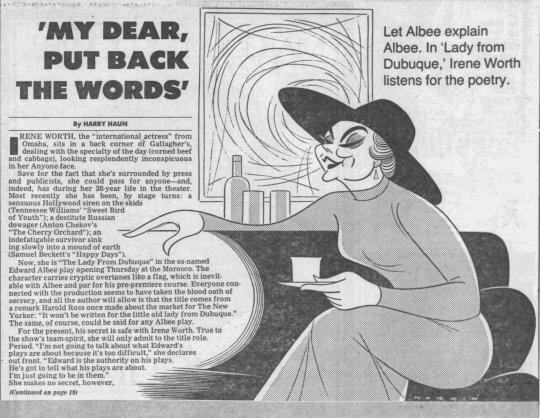
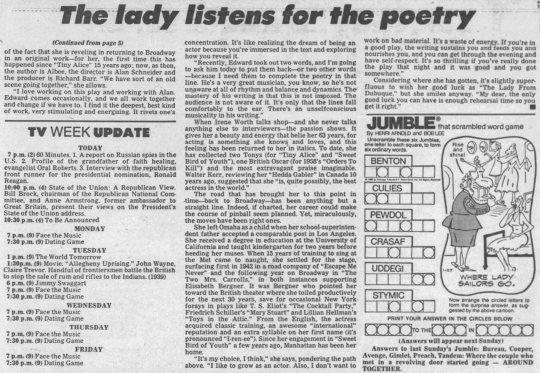
Irene Worth, the "international actress" from Omaha, sits in a back corner of Gallagher's, dealing with the specialty of the day (corned beef and cabbage), looking resplendently inconspicuous in her Anyone face.
Save for the fact that she's surrounded by press and publicists, she could pass for anyone and, indeed, has during her 38-year life in the theater. Most recently she has been, by stage turns: a sensuous Hollywood siren on the skids (Tennessee Williams "Sweet Bird of Youth"); a destitute Russian; dowager (Anton Chekov's "The Cherry Orchard"); an indefatigable survivor sinking slowly into a mound of earth (Samuel Beckett's "Happy Days").
Now, she is "The Lady From Dubuque" in the so-named Edward Albee play opening Thursday at the Morosco. The character carries cryptic overtones like a flag, which is inevitable with Albee and par for his pre-premiere course. Everyone con nected with the production seems to have taken the blood oath of secrecy, and all the author will allow is that the title comes from a remark Harold Ross once made about the market for The New Yorker: "It won't be written for the little old lady from Dubuque." The same, of course, could be said for any Albee play.
For the present, his secret is safe with Irene Worth. True to the show's team-spirit, she will only admit to the title role. Period. "I'm not going to talk about what Edward's plays are about because it's too difficult," she declares out front. "Edward is the authority on his plays. He's got to tell what his plays are about. I'm just going to be in them." She makes no secret, however, of the fact that she is reveling in returning to Broadway in an original work—for her, the first time this has happened since "Tiny Alice" 15 years ago; now, as then, the author is Albee, the director is Alan Schneider and the producer is Richard Barr. "We have sort of an old scene going together," she allows.
"I love working on this play and working with Alan. Edward comes occasionally, and we all work together and change if we have to. I find it the deepest, best kind of work, very stimulating and energizing. It rivets one's concentration. It's like realizing the dream of being an actor because you're immersed in the text and exploring how you reveal it.
"Recently, Edward took out two words, and I'm going to ask him today to put them back—or two other words—because I need them to complete the poetry in that line. He's a very great musician, you know, so he's not unaware at all of rhythm and balance and dynamics. The mastery of his writing is that this is not imposed. The audience is not aware of it. It's only that the lines fall comfortably to the ear. There's an unselfconscious musicality in his writing."
When Irene Worth talks shop—and she never talks anything else to interviewers—the passion shows. It gives her a beauty and energy that belie her 63 years, for acting is something she knows, and loves, and this feeling has been returned to her in italics. To date, she has collected two Tonys (for "Tiny Alice" and "Sweet Bird of Youth"), one British Oscar (for 1958's "Orders To Kill") and the most extravagant praise imaginable. Walter Kerr, reviewing her "Hedda Gabler" In Canada 10 years ago, suggested that she "is, quite possibly, the best actress in the world." The road that has brought her to this point in time back to Broadway has been anything but a straight line. Indeed, if charted, her career could make, the course of pinball seem planned. Yet, miraculously, the moves have been right ones. She left Omaha as a child when her school-superintendent father accepted a comparable post in Los Angeles. She received a degree in education at the University of California and taught kindergarten for two years before heeding her muses. When 15 years of training to sing at the Met came to naught, she settled for the stage, surfacing first in 1942 in a road company of "Escape Me Never" and the following year on Broadway in "The Two Mrs. Carrolls," in both instances supporting Elisabeth Bergner. It was Bergner who pointed her toward the British theater where she toiled productively for the next 30 years, save for occasional New York forays in plays like T. S. Eliot's "The Cocktail Party," Friedrich Schiller's "Mary Stuart" and Lillian Hellman's "Toys in the Attic." From the English, the actress acquired classic training, an awesome "international" reputation and an extra syllable on her first name (it's pronounced "I-ren-ee"). Since her engagement in "Sweet Bird of Youth" a few years ago, Manhattan has been her home.
"It's my choice, I think," she says, pondering the path above. "I like to grow as an actor. Also, I don't want to work on bad material. It's a waste of energy. If you're in a good play, the writing sustains you and ieeds you ana nourishes you, and you can get through the evening and have self-respect It's so thrilling if you've really done the play that night and it was good and you got somewhere."
Considering where she has gotten, it's slightly superfluous to wish her good luck as "The Lady From Dubuque," but she smiles anyway. "My dear, the only good luck you can have is enough rehearsal time so you get it right."
3 notes
·
View notes
Photo



Original Practices and the American Shakespeare Center have a staunch advocate in Vanessa Morosco. Brilliant! #Shakespeare https://stateofshakespeare.com/?p=8987
0 notes
Photo

Marilyn Monroe arriving at Morosco Theatre in New York, on March 24, 1955.
2K notes
·
View notes
Text
On This Day
22 January 1938
Our Town by Thornton Wilder premiered at the McCarter Theatre in Princeton, New Jersey.
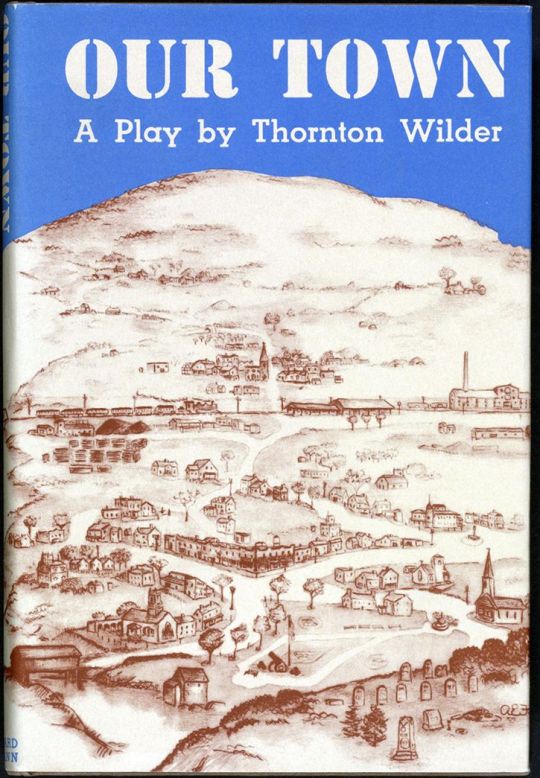

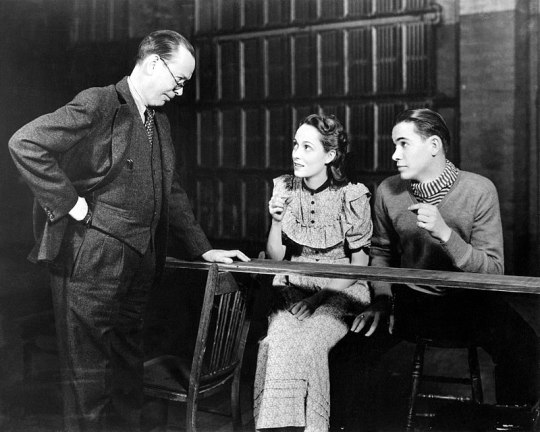
It soon after opened at the Wilbur Theatre in Boston on January 25. It moved to the Henry Miller's Theatre in New York on February 4, then later moved to the Morosco Theatre.
Wilder won the Pulitzer Prize for Drama in 1938 for Our Town.
#theatre#theater#history#dramatist#dramatic literature#on this date#on this day#this day in history#thornton wilder#our town#1930s#dark academia#light academia#classic academia#stage play#metatheatre#pulitzer prize#stage#literature
1 note
·
View note
Text


Durfee was an actress in a stock musical company who met and married Roscoe Arbuckle in Long Beach, California on August 6, 1908, and joined Keystone with him in 1913. Over the next 3 years she would appear in about 50 Keystone Comedies, both with Fatty and with other comedians, demonstrating her talent as a comedienne, which unfortunately went under-utilized after her Keystone days.
Born in Los Angeles to a railroad engineer, Durfee appeared on stage with the Morosco, Kolb, and Dill and Ferris Hartman companies before her film career. She left Keystone with Arbuckle to go to New York, but did not appear in his Comique shorts and stayed on the East Coast for stage roles when the two separated. In 1919, Minta starred in two-reel comedies produced in the East for Truart Pictures, Inc. Though separated from Roscoe she supported him during his famous trial, and in later years would return to the screen from time to time in bit roles and extra parts, in films. Durfee died at the Motion Picture Home in Woodland Hills, California, of a heart ailment at 85, leaving brother Paul. She's interred at Forest Lawn Memorial Park, Glendale.
-Walker, B.E., 2010, Mack Sennett's Fun Factory, McFarland&Company, Inc., Publishers, p.500
0 notes
Video
Не пей воду - комедия США 1994 Вуди Аллен, Майкл Дж. Фокс, Джули Кавнер
Фильм снят по пьесе Вуди Аллена. Разгар холодной войны. Еврейскую семью из Нью-Йорка по ошибке принимают за шпионов. Семейство прячется в американском посольстве, где сложившуюся ситуацию пытается урегулировать сын посла, так как сам посол в Вашингтоне.
#комедия #экранизация #киноклассика
Выпущено: США, Jean Doumanian Productions, Magnolia Productions, Sweetland Films
Режиссер: Вуди Аллен
В ролях: Вуди Аллен, Майкл Дж. Фокс, Джули Кавнер, Майем Биалик, Дом ДеЛуис, Эд Херлихи, Йозеф Зоммер, Роберт Стэнтон, Эдвард Херрманн, Розмари Мёрфи
Перевод: Профессиональный (двухголосый закадровый) - SDI Media
* Сценарий фильма написан Вуди Алленом на основе одноименной пьесы, поставленной на Бродвее в 1966 году. После просмотра первой экранизации пьесы — "Не пейте воду" (1969), Аллен счел ее посредственной и решил снять свою версию.
* Оригинальная бродвейская постановка "Не пейте воду" была впервые поставлена на сцене театра Morosco 17 ноября 1966 года, а всего было 598 спектаклей.
0 notes
Audio
When Side by Side by Sondheim moved to the Morosco for its final month, Burr Tillstrom joined the cast, bringing Kukla and Ollie with him. “The Two of You” was added to the show, a song written many years before and sent to the Kukla, Fran and Ollie show when Sondheim was hoping to have a song on television. It was rejected. Nancy Dussault sings the song with Kukla and Ollie in this live recording.
0 notes
Text
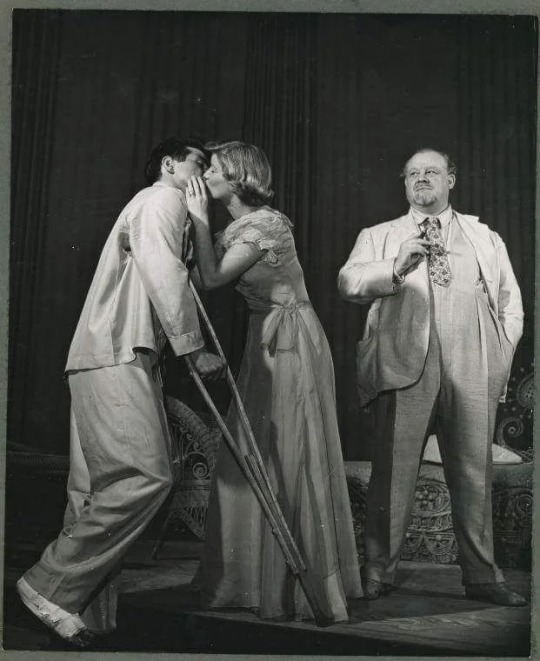
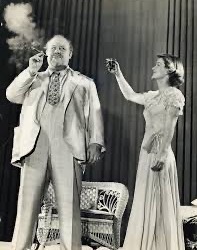

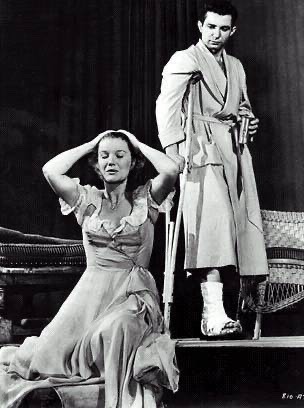

The original Broadway production of “Car On a Hot Tin Roof” opened at the Morosco Theater #OnThisDay in 1955. Directed by Elia Kazan, the play starred Barbara Bel Geddes, Ben Gazzara, Burl Ives, and Mildred Dunnock, and won Williams his second Pulitzer Prize.
35 notes
·
View notes